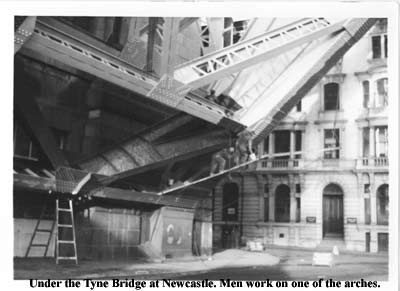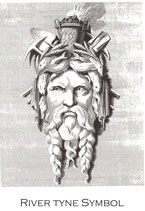
BRIDGES - STRUCTURE

"But one has only to consider such great steel arches as that of the Sydney Harbour Bridge or here in our own country, the Tyne Bridge, to realise the purposeful beauty that can be obtained with steel and which would be quite impossible with concrete."
The Work Of The Bridge Builders, J Gordon Peirson. 1948.
Methods to overcome the obstacle presented by rivers, has involved ford, ferry, bridge and tunnel. The Romans built the first sizeable bridges on the Tyne, notably at Newcastle, Corbridge and Chesters using timber and stone. In medieval times these were replaced by stone-arch bridges but were not necessarily proof against a sustained flood. Bridges were built appropriate to the location. Several narrow arches allowing for flooding were used on low land bridges, broad piers on shallow foundations spreading the load. Tall, wide-arched bridges were used where the water was deep at all seasons. Sudden, violent floods had to be provided against, cutwaters on each pier helping to deflect water and debris alike. Tide was another factor, necessitating the construction of coffer dams while foundation laying was in progress. Bridges could be supported either on stone piers, or on timber piles driven into the river bed when it was leaky. Stonemason's who built the churches and cathedrals learned about arch design and applied their knowledge to bridge building.
The railways presented new problems, needing to cross on the level and bear considerable weight. Timber was often used initially, being replaced later by iron or steel. The Tyne gorge was first bridged by the High Level Bridge and while the Newcastle and Carlisle railway was crossed by low bridges, branch lines often had soaring viaducts. Road bridges were of steel or concrete and as traffic and loads increased cost became an increasing factor leading to new designs and innovations. Finally, the need for big ship access further upstream led to replacement of the low bridge at Newcastle by the Swing Bridge, and navigational clearances required high bridges without mid-river piers, as with the single span Tyne Bridge and its successors.
Tunnels were used nearer the river mouth to avoid navigation problems in bridging low lying land. Footbridges on the South and North Tyne were often just simple beam bridges.
- Abutment - support against which arch rests.
- Buttress - Brickwork or masonry giving added stength to bridge and projecting from it
- Pier - the arch supports.
- Spandrel - wall carried by arch supporting the road. Often pierced with circular hole to reduce weight.
- Cutwater - angular edge of bridge pier.
- Voussoirs - wedge-like stones forming arch.
- Arch - stones supporting each other by mutual pressure.
- Keystone - central wedge of shaped stone at apex of an arched bridge.

